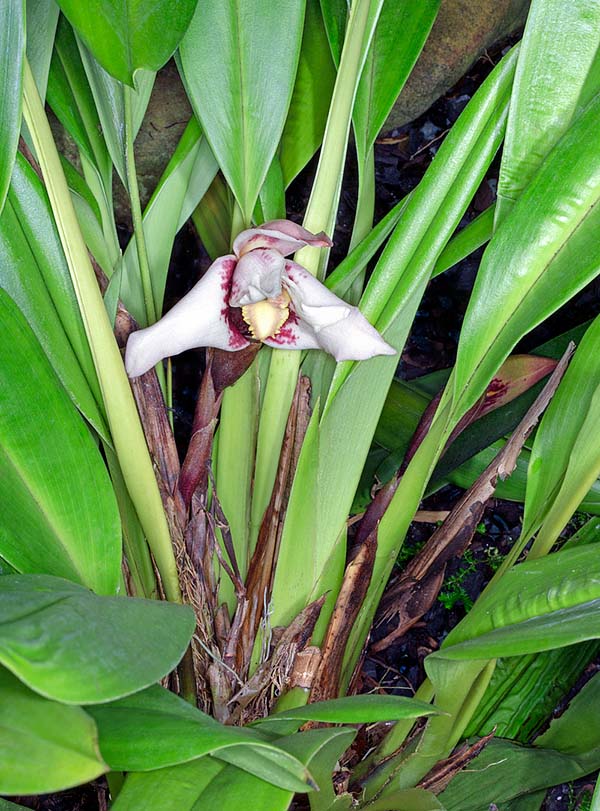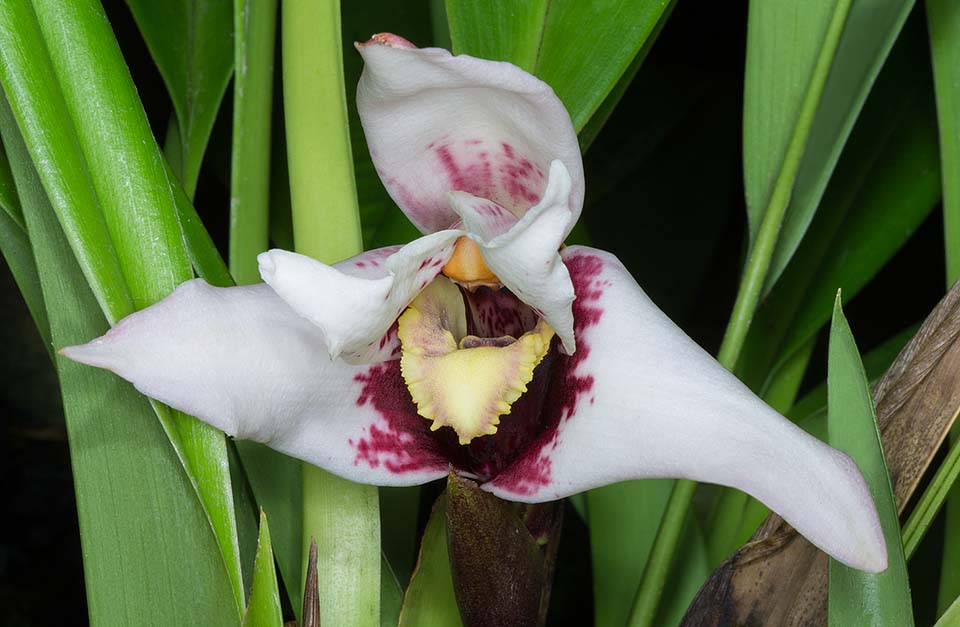Family : Orchidaceae

Text © Pietro Puccio

English translation by Mario Beltramini

Native to the misty Ecuador and Peru forests, the Maxillaria sanderiana is an epiphyte or lithophyte with creeping rhizome, ovoidal 5-10 cm pseudobulbs, compressed laterally, and leaves of about 40 cm © Giuseppe Mazza
The name of the genus comes from the Latin adjective “maxillaris, e” = maxillar, relevant to the maxilla, with reference to the shape of the nectarium; the species is honoured to the German horticulturalist Henry Frederick Conrad Sander (1847-1920), founder of the monthly publication “Reichenbachia” dedicated to the orchids.
Common names: Sander’s Maxillaria (English).
The Maxillaria sanderiana Rchb.f. ex Sander (1888) is an epiphytic or lithophytic species, cespitose, robust, with creeping rhizome, filiform roots and ovoidal pseudobulbs, compressed laterally, 5-10 cm long, provided at the apex of one oblong-elliptical leaf with acute apex, up to about 40 cm long and 5-7 cm broad. Ascending or sem-drooping basal inflorescences, 10-25 cm long, on a peduncle provided of imbricate bracts, 2,5-3,5 cm long, with one single flower, of 10-13 cm of diameter, fleshy, with white sepals and petals, less frequently white-pinkish, with dark purple spots at the base and yellow labellum; the flowers emit a pleasant fragrance and last 2-3 weeks. Oblong-lanceolate dorsal sepal with acute apex, concave, 5,5-6,5 cm long and 1,7-2 cm broad, lateral sepals similar to the dorsal, united at the base of the column to form a sort of spur (mentum). Obliquely lanceolate petals with acute apex, 4,5-5 cm long and 1,5-1,8 cm broad, trilobed labellum, curved, about 3,5 cm long, lateral lobes just hinted and ovate median lobe with wavy margins, clavate, 1,5 cm long, column.
It reproduces by seed, in vitro, and by division, with each section provided at least of 3-4 pseudobulbs, at the vegetative restart.
Floriferous species with big flowers, among the biggest of the genus, fragrant and long lasting, of not quite easy cultivation due to its particular needs. It requires a semi-shady position, cool to intermediate temperatures, with summer highest not exceeding the 26 °C and winter lowest not under the 10 °C, with high daily thermal excursion, and high humidity, 70-80 %; essential is a good ventilation to avoid the onset of rottennesses. Frequent waterings during the growth of the pseudobulbs, more spaced during the vegetative rest, maintaining always the substratum moderately humid, utilizing rain water, demineralized or by reverse osmosis. It is usually cultivated in suspended baskets, seen that the floral peduncle is at times emitted bending down, with a particularly draining compost that may be formed by fragments of medium sliced bark and charcoal with addition of sphagnum or coir in order to maintain the humidity.

13 cm flowers with nectarium like a maxilla, as states genus name. Perfumed and long-lasting but difficult to cultivate due to the particular environmental needs © Giuseppe Mazza
The species is reported in the appendix II of the CITES (species whose trade is internationally ruled).
Synonyms: Maxillaria sanderiana var. atropurpurea H.Williams (1894); Maxillaria sanderiana f. atropurpurea (H.Williams) Christenson (2010); Maxillaria sanderiana f. xanthina Christenson (2010).
→ For general notions about ORCHIDACEAE please click here.
